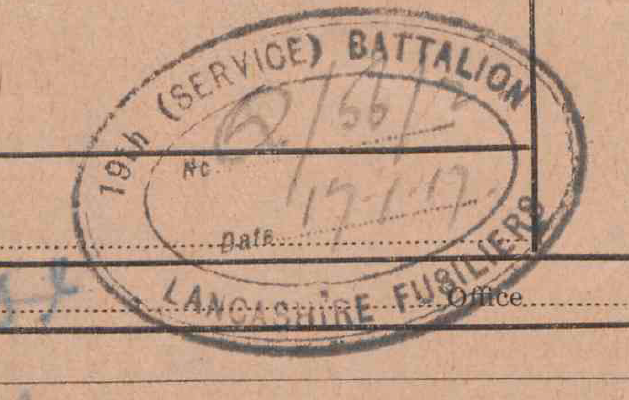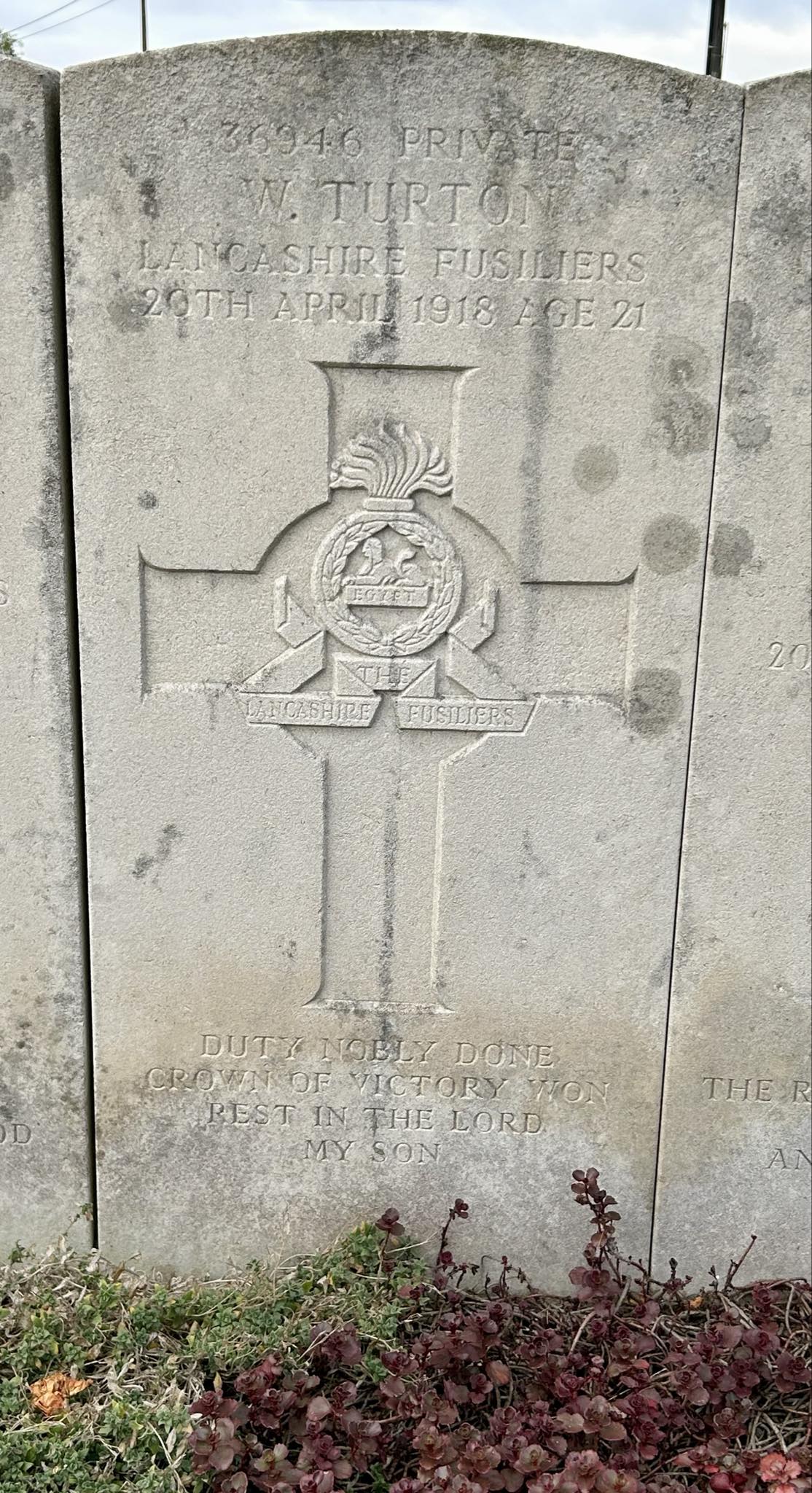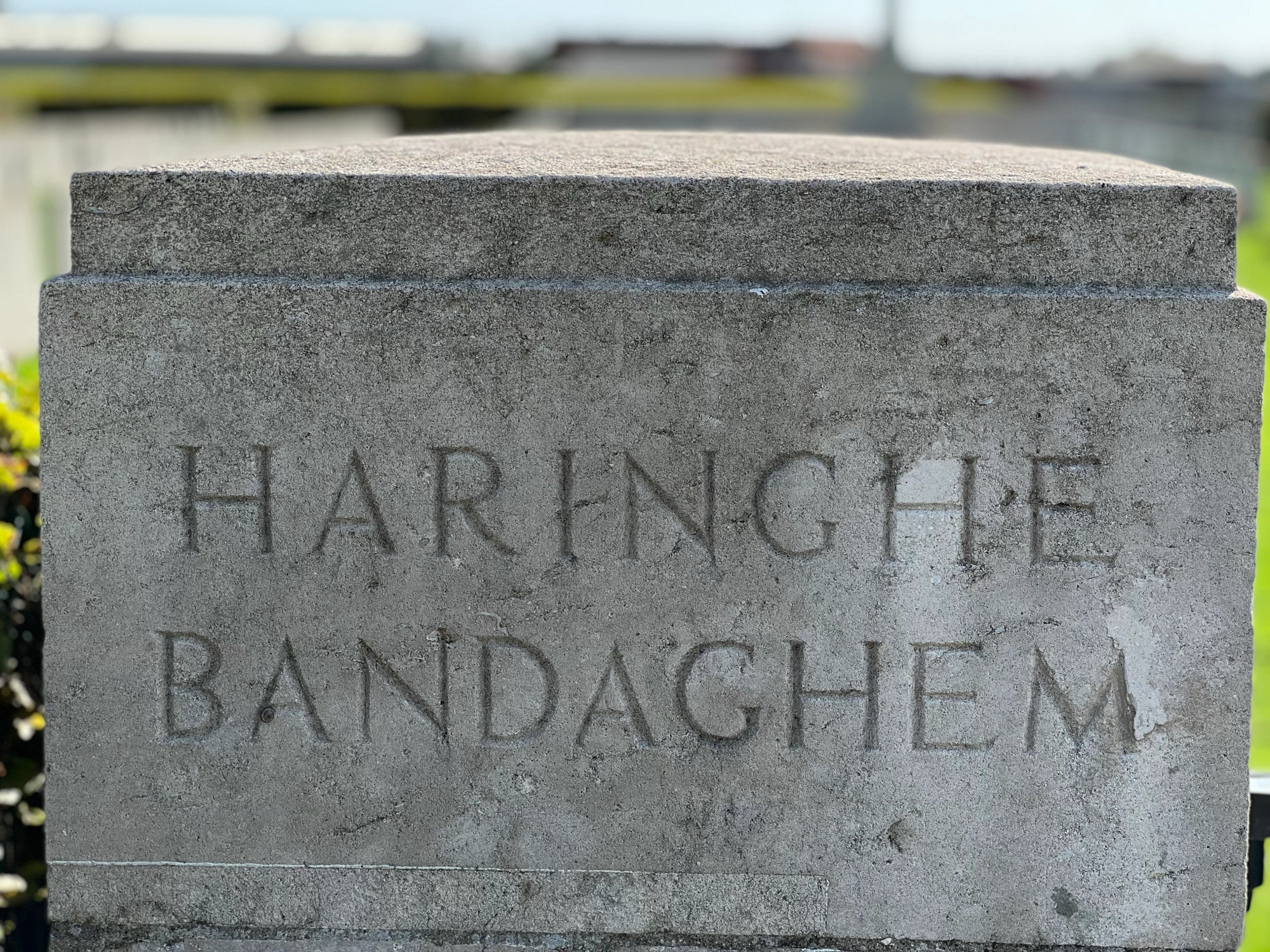The Yew Tree

Introduction
In June 1918, during the last year of the Great War, Richard and Elizabeth Turton of 13 Pretoria Road, Ashton in Makerfield received notification from the War Office that their son Walter had died of wounds whilst on active service on the Western Front. At the time Walter's older brother John was also serving overseas with the Royal Army Medical Corps in Mesopotamia (today's Iraq).
Early Life
Walter Turton was born 27 February 1897 at 22 Old Road in Ashton and was baptised two weeks later on 14 March at St. Thomas’s (CE) Church in Warrington Road. He was the youngest of ten children, six girls and four boys, born to Richard and Elizabeth (nee Wareing), who was a native of Banks in Southport.
After their marriage in Wigan in 1877 the couple lived at various addresses in Ashton including Town Green, Bolton Road, Stone Croft Terrace, Old Road, and finally 13 Pretoria Road, adjacent to Jubilee Park on Wigan Road.
Walter started his education at the age of seven. The admissions register of the Emmamuel School in Wigan Road, Ashton (known by locals as the British School) shows that Walter enrolled in the Infants Department on 15 August 1904.
Enlistment in the Colours
Unfortunately Walter’s service records have not survived. They were lost in September 1940 during the Blitz, when the Records Repository in Arnside Street, Walworth, South London was set ablaze by incendiary bombs. Approximately two-thirds, (6.5 million) of the British Army's First World War records of all categories were destroyed by fire. (The surviving records held at the National Archives at Kew in London are known as the ‘Burnt Collection’).
By using other available source such as war diaries, trench maps, and divisional operation orders his military career can be pieced together and his movements on the Western Front traced.
Walter answered the call to the colours and attested at Ashton in December 1915 under the Derby Scheme. A scheme initiated by the Earl of Derby to encourage men aged 18 to 41 to register their willingness to serve and be called up later when needed. The scheme was to lead to the introduction of conscription and compulsory military service for all by May 1916.
The men who attested were given an armband and classified into married and single status and into 23 groups according to age. The armband was to show that the wearer was registered to enlist and to prevent them being labelled as cowards and receiving white feathers from women, many of whom had lost loved ones in the conflict.
Walter was in Group 1 which would be called up first, he continued working at the boot and clog business run by Henry Wareing at 333 Wigan Road, Bryn until he was called up a few months later. He was issued the service number of 277772 and posted to 10th Battalion South Lancashire Regiment, a training unit based at Bodelwyddan, near Rhyl in North Wales.

Pte. Walter Turton 'C' Company, 19th Battalion Lancashire Fusiliers
In May 1916 Walter was transferred to 2nd/1st Battalion Monmouthshire Regiment based at Bedford. The 2nd/1st was a second line Territorial Force battalion whose role was to provide reinforcements to its first line battalion serving overseas.
By August 1916 the France based Territorial Monmouthshire Battalions were starting to disband with the men posted to other units. Walter was posted to an infantry depot in France on the 28th of August and nominally posted for administrative purposes into the 4th Reserve Battalion of the Lancashire Fusiliers. Here he received a new service number of 36946 and further combat training before being posted once again to 19th (3rd Salford Pals) Battalion, Lancashire Fusiliers.
After suffering heavy casualties in the early stages of The Battle of the Somme two months previously the battalion had reformed as a Pioneer battalion. On 6 August 1916 19th Battalion Lancashire Fusiliers commanded by Lieutenant Colonel J.M.A Graham DSO joined the 49th (West Riding) Infantry Division, which was part of 7 Corps, commanded by Lieutenant General Sir Thomas D'Oyly Snow.
The three infantry brigades in the division were made up of the West Yorkshire Regiment, Duke of Wellington's Regiment, King's Own Yorkshire Light Infantry and the York & Lancaster Regiment.

The cap badge of the Lancashire Fusiliers (20th Foot)
Pioneer
Pioneer battalions were fully trained infantrymen and could be called upon to fight alongside other infantry units when needed. They were employed in numerous roles including digging, repairing, and maintaining front line trenches, dugouts, and communication trenches, as well as constructing and dismantling barbed wire obstacles.
They also constructed and repaired roads and bridges to facilitate the movement of troops, ammunition, supplies and other essential materials. Much of the pioneer's work, particularly trench maintenance and obstacle construction, was done at night to minimize exposure to enemy fire. Pioneer battalions worked closely with the Royal Engineers. The Fusiliers came under the direct orders of the 49th Division Commander, Major General M. Percival.
Walter was among a batch of 194 replacements who joined the battalion on 11 September 1916 at Hedauville, five miles northwest of the strategic town of Albert. Ten days later 'C' Company along with 'A' and 'B' Companies were employed in the Leipzig Salient opening up communication trenches in preparation for the successful attack on the German strong point at Thiepval, known as the Schwaben Redoubt, which took place on 25 September. The companies were then bussed to billets in Coullemont, thirteen miles to the west.
On 2 October, the battalion moved to the Souastre area under the orders of the Commander Royal Engineers. On 1 November 'C' Company proceeded to Sailly-Au-Bois for eleven days, before returning to Souastre.
The Battle of the Somme finally ended on 18 November after four and half months of bitter fighting when both sides consolidated their positions. the total number of casualties on all sided was over a million. British casualties numbered 420,000 killed, wounded or missing, 57,000 of these on the first day alone. By the end of the campaign the Allies had advance only seven miles.
By 1 December the whole battalion was in billets in Souastre where 'C' Company was employed on road work with the Royal Engineers. Five days later the Fusiliers were taken out of the line and relieved by the Pioneers of 1st Battalion Monmouthshire Regiment from the 45th Division.
They proceeded to the Lucheux area where Walter's Company was billeted at La Fontaine Farm. Here they bathed, rested, re-equipped and absorbed replacements from various infantry regiments. On Christmas Day 1916 the whole battalion was given a days holiday.
1917
The work details for the pioneers was varied but relentless. New Years Day 1917 found Walter working in the Lucheux Forest cutting wood to be used for fascines (bundles of branches bound together, used for filling in marshy ground or for strengthening the sides of embankments or trenches).
On 8 January 1917 the battalion moved north up to the Front Line and concentrated in the La Cauchie area, eight miles south west of the city of Arras.. 'C' Company were billeted nearby at Berles-Au-Bois.
On the 12th 'C' Company were revetting communication trenches with 57 Field Company Royal Engineers in the Divisional Reserve Sector. (revetting is a method of reinforcing trench walls to prevent collapse due to rain, erosion, or enemy fire. It involved using various materials like wood, sandbags, or corrugated iron to stabilize the trench sides).

The stamp from a battalion operational order date 17 January 1917
On the 25th of January 'C' Company travelled to Laherliere to work for the railway engineers, the following day they moved to Guardiempre to do the same work near Warlincourt.
The casualty states for January were one officer and eleven other ranks wounded by shellfire and two other ranks were killed. Reinforcement drafts totalling twenty men arrived.
The battalion stayed in the La Cauchie area for the whole of February on work details. The freezing weather hampered work on the trenches and on the 20th was cancelled all together as in parts the ground was frozen to a depth of 22 inches. On the 23rd a Signaller was diagnosed with German Measles, causing all the signallers and anyone else who had come into contact with him to be immediately placed in quarantine.
Two days later the battalion received orders to move at one hours notice as the enemy had vacated their trenches on the front line opposite 'V' Corps positions. This order was cancelled the following morning and work continued as normal. Unbeknown to the Allies, on the 9th of February the Germans had launched 'Operation Alberich' the phased strategic withdrawal back to the prepared second line of defences, the Hindenburg Line.
On 4 March the battalion left for a new sector of the line. 'C Coy marched six miles from Riviere to L'Arbret, they were then bussed 50 miles north via Doullens, St. Pol, Lillers and St. Venant to Merville, from there they marched another six miles via Estaires to billets at Laventie, recently vacated by 1/5th Battalion Cheshire Regiment, the pioneer unit of 56th Division.
'C' Company spent the remainder of the of the month and on into April on familiar tasks of strengthening trenches or building access roads to communication trenches. Most of the work being done at night. On 24 April Laventie was heavily shelled causing eleven casualties, one of whom later died of his wounds. For their actions an officer and two men received certificates of gallantry for tending to the wounded under shell fire.
Three days later the Fusiliers were visited by the Commander of VI Corps, Lieutenant General Sir James D.L Haldane who presented ribbons of decorations to members of the battalion. These consisted of a Military Cross, a Distinguished Conduct Medal, three Military Medals and a Croix De Guerre. The fighting strength of the battalion at the end of April 1917 stood at 32 officers and 920 other ranks.
During the month of May Laventie was shelled on a regular basis but luckily the Fusiliers suffered very few casualties. At 0300 hours on 7 May the battalion was on stand by as a gas bombardment by 24 mortars and 1,000 projectiles was made on the German positions. The following day Walter and his company moved to new billets at Bois Deville to make way for a Portuguese Field Company of 63 men along with their vehicles, horses and mules, whom the battalion hosted for eight days.
Move to the Coast
After three months at Laventie the Fusiliers were ordered to move north to Dunkerke. At 2000 hours on 8 July they left La Gorgue by rail, travelling via Merville and Hazebrouck they arrived at Dunkerke at 0530 the following morning. Later that day they were transported sixteen miles over the border to Oostduinkerke in Belgium. The battalion were temporarily attached to the 1st Infantry Division for administrative purposes.
Just before the battalions arrival the Germans commenced shelling the camp and surrounding vicinity with high explosive shells. This continued intermittently all night and the companies had to take shelter in roadside ditches and in the sand dunes.
At 0600 hours on the 10th the enemy commenced a bombardment of the rear areas and at 1000 hours the intensity increased. It was subsequently discovered that this was a preliminary to a serious attack on the front line trenches north of the River Yser at Nieuwport Bains on the Belgian North Sea coast. This was the extreme left flank of the Western Front, from here the line of trenches stretched 475 miles to the Swiss border.
The battalion spent the day in the trenches at the side of the road, suffering 23 casualties in the process. The artillery fire continued all evening forcing the troops to spend another night in shelter trenches.
The next morning the companies sent all available working parties up to the front line but owing to the gas bombardment men were not able to work more than a half hour at a time. The battalion suffered 16 wounded, two of which later died of their wounds, a further 32 other ranks suffered from gas poisoning.
Despite the setback work continued on repairing the damage done by the artillery bombardments, the companies were kept busy filling sand bags and carrying supplies for the repair of bridges. Owing to the sandy conditions and high water table it was virtually impossible to dig trenches so they had to be constructed using breastworks which protruded above ground, these had to be repaired which was a dangerous job. On the 22nd a draft of 44 replacements arrived, mostly from the Kings Royal Lancastrian Regiment.
The end of month summary by the Commanding Officer states that 126 men of 'C' and 'D' Companies still remained in camp suffering from the effects of gas. The fighting strength of the battalion was 30 officers and 800 other ranks. The weather during July had been exceptionally good.
Minden Day, observed on 1 August is a significant regimental anniversary for the the Fusilier regiments, commemorating their participation in the Battle of Minden in Germany during the Seven Years' War of 1759. The Lancashire Fusiliers, successors to the 20th Regiment of Foot, played a key role in the battle and are honored on this day with traditions like wearing red roses and participating in commemorative ceremonies.
The regimental war diary for 1 August noted briefly that no celebrations were possible that day and the weather was very wet. During August the companies moved up to Nieuwpoort on the front line, employed in carrying supplies to forward dumps, revetting trenches and constructing bridges in sections for the River Yser and the Yser Canals.
The battalion was withdrawn from the front line on 13 September and route marched south to the Adinkerke area on the French border. Here they were transported by barge along the Furnes Canal to billets at Malo les Bains and Rosendael near Dunkerke. Here the fusiliers spent ten days sharpening their infantry skills on the rifle ranges, practiced bayonet fighting, and underwent physical fitness training, and route marches.
On the 24 September the Battalion was bussed 16 miles south to Lederzeele for more training. Three days later on the 27th they were bussed to Vlamertinghe near Ypres, then marched to Camp No 4 south of Ypres.
They were about to enter the Third Battle of Ypres, more commonly known as 'The Battle of Passchendael'. Two days later they were working on the light railway track under the orders of the 2nd Battalion Canadian Railway Troops from the 2nd Canadian Corps.
On 5 October the Battalion moved from the Ypres South Camp into the Ypres Salient. The war diary states that next day a replacement draft 339 other ranks arrived from the 1st Reserve Battalion Royal Engineers but they had had practically no military experience. They were transferred to the Territorial Battalions of the Lancashire Fusiliers of the 66th Division. Three days later this draft went into action for the first time in the bloody battle for the Passchendael Ridge.
On 24 October the battalion received a letter of commendation via Major General Neville J.G Cameron the Commander of 49th Division from Lieutenant General Sir Arthur W. Currie, the Commander of the Canadian Corps. He was full of praise for the work done on the railways by the Fusiliers for the Canadians and the way they had conducted themselves during the battles.
Two days later 19 Battalion left the Ypres area and moved to rest billets at Oudezeele, five miles over the border in France. During their time in the Ypres Salient so far the battalion had suffered nine killed and 68 wounded, mainly from shell fire.
They stayed at Oudezeele until 8 November, on that day eight members of the battalion were awarded medals for gallantry and distinguished service in the field. A senior NCO received a bar to his Military Medal and seven others received the Military Medal.
The next day the Fusiliers were bussed fourteen miles east to Dickebuusch, south of Ypres. The weather was bad and the camp was very muddy and in bad condition. The accommodation was in tents. On the 10th parties of men went to the forward area to relieve the 2nd Australian Pioneer Battalion. During the rest of the month the battalion was constantly on the move providing work parties.
The Battle of Passchendaele which failed to achieve its objectives ended that month and has become a symbol of the futility and brutality of trench warfare in World War I. It lasted over 100 days. In a scenario similar to the Battle of the Somme the year previously the Allies advanced about 5 miles for the loss of over 250,000 soldiers killed, wounded or missing.
Work continued as normal during the month of December repairing tracks and roads devastated by shell fire. A steady stream of casualties occurred due to hostile shell fire. On Christmas Day 1917, by orders of the Divisional Commander all working parties ceased work at 11.30 and returned to camp. The men's dinner was supplemented with extra rations purchased from Regimental Funds.
1918
During January and February the work continued as normal on the tracks, roads and trench system in the Ypres Salient interspersed with visits to rest billets. On the 23rd the Battalion was a given a day off.
The war diary notes that during the month ten officers and 215 other ranks had arrived as draft replacements to compensate for the constant stream of casualties. A significant number of these were transferred to 3rd/5th Battalion Lancashire Fusiliers.
Work continued as normal in the Salient during the month of March. The Fusiliers providing work parties in the Zonnebeek, Westhoek and Frezenburg areas. Shelling increased along with the casualties. On the 18th 'C' Company commenced work on a new communication trench. Three days later work was stopped when their position was bombarded with gas shells, forcing a withdrawal to the rear area. At the same time 'A' Company was heavily shelled with high explosive.
The Battle of Lys
In April 1918 19th Battalion Lancashire Fusiliers fought in the Battle of Lys, (also known as the Fourth Battle of Ypres) part of the larger German Spring Offensive. The aim of the Germans was to capture Ypres and force a way through to the Channel Ports and cut off the Allies supply lines.
The role of the battalion was the defence of Mount Kemmel, a key feature on the French-Belgian border. They moved into position on 11 April and for eight days suffered very heavy shelling, and on 17 April 'A' Company fought off an enemy ground attack. They were relieved by French troops during the night of 18/19 April. During this period the battalion suffered thirteen killed and 88 wounded in action.
Walter was one of the wounded, he was evacuated to No. 36 Casualty Clearing Station (CCS) at Roesbrugge-Haringhe, some six miles north west of the city of Poperinghe. Here he died of his wounds on 20 April 1918 at the age of 21. Walter was buried in the Haringhe Bandaghem Military Cemetery, in Plot V. Row C, Grave 23. The personal inscription on his headstone reads:
‘DUTY NOBLY DONE CROWN OF VICTORY WON REST IN THE LORD MY SON’

Walter Turton's headstone

Haringhe Bandaghem Cemetery, West Vlaanderen, Flanders
The cemetery is on the site of the Casualty Clearing Station at Haringhe which troops gave the nickname of ‘Bandaghem’, two other casualty clearing stations in the area were given the nicknames of ‘Dozinghem’ and ‘Mendinghem’, reflecting their use in tending for the wounded: Bandaging Them, Dosing Them Up, and Mending Them.

Haringhe Bandaghem Cemetery adjacent to the Casualty Clearing Station
After their son's death various gratuity payments were made to Elizabeth and a Dependents Pension was awarded on 26 Oct 1918, the sum of seven shillings per week to be paid from 19 Nov 1918.
Pilgrimage
The 1921 Census shows Walter's father Richard employed as a plasterer at Haydock Collieries owned by Richard Evans & Co. That year he and Elizabeth visited their son’s grave in Flanders. A Yew tree sapling was taken from the cemetery by the authorities and gifted to them.
On their return it was agreed with the Ashton in Makerfield Urban District Council, that the sapling would be planted by the Parks Department in Jubilee Park in such a position that it could be viewed from their Pretoria Road residence.
Elizabeth Turton died in 1934, aged 76. Richard left Pretoria Road to live with his son Robert and his family at 82 Wargrave Road in Newton Le Willows. He died in 1946, aged 88.
The Yew Tree has thrived in Jubilee Park and today, 104 years later stands as a lasting memorial to Walter and the other brave servicemen in the Ashton in Makerfield area who paid the ultimate sacrifice.

The Yew tree in Jubilee Park, Ashton in Makerfield

In 2015 relatives of Walter unveiled a commemorative information plaque on the footpath in Jubilee Park under the shade of the Yew tree.
Lest We Forget
Graham Taylor 2025
Acknowledgements
Thanks to members of the Great War Forum for their assistance with military records.
Sources
Ancestry UK
British Newspaper Library - Find My Past
Commonwealth War Graves Commission
Farthingdale Publications - C.D Taylor
Find My Past - British Newspaper Library
Great War Forum
Imperial War Museum - War Graves Register
Lancs BMD
National Archives -19 Bn LF War Diaries
The Long Long Trail
Wigan Archives-Schools Admission Registers
Wikipedia
Example Text